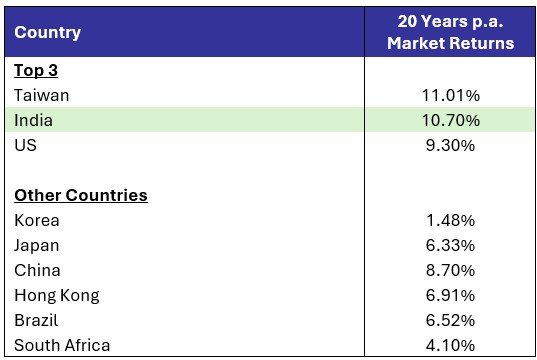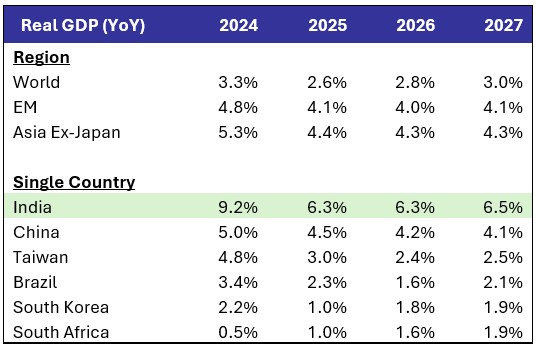Why single can be better...
In an increasingly interconnected world, investors often gravitate towards emerging market (EM) or Asia regional funds to pursue growth whilst spreading risk through diversification. However, diversification isn't always synonymous with optimal performance. As the past 25 years and the forward-looking data suggest, investors might achieve stronger results by concentrating their exposure in high-growth, structurally sound economies. Among these, India's credentials stand out as a long-term outperformer.
What Has Worked: The Power of Concentration
World indices, Asia funds and broad emerging market funds suffer from what economists call the "diversification trap." By spreading investments across multiple countries, these funds inevitably include both winners and losers. In broad indices like MSCI World, MSCI EM, or MSCI Asia ex-Japan, exposure to strong-performing markets like India is often offset by underperformers like Hong Kong, Brazil, South Africa or even China in recent years.

Source: MSCI, each country is represented by the broad country MSCI net return index, returns in AUD, data as of 30/06/2025
India has delivered superior long-term performance, topping the table over the last 20 years. Yet despite this consistent outperformance, its representation in diversified indices like MSCI EM remains modest (~15-16%), often dwarfed by China.
What’s Next?
The forward-looking earnings growth data reinforces the case for single-country concentration, particularly in select Asian markets. Whilst countries like South Korea and Taiwan illustrate strong earnings recoveries, the cyclicality of their earnings stands out (as expressed in volatility). The broader benchmarks like Asia ex-Japan, EM and MSCI World also have their earnings diluted by the presence of some weaker geographic regions. India is one market which illustrates robust and low volatility earnings (bottom right quadrant).
This disparity illustrates how broad regional funds can significantly underperform their best constituent markets.

Source: MSCI and Bloomberg, each country is represented by the broad country MSCI index, data as of 30/06/2025
India is projected to be the fastest-growing major economy over the next 3-5 years, maintaining a pace more than double that of most developed markets. The growth differential is particularly stark when compared to other major emerging market constituents. China, the largest component of most emerging market indices, shows a declining growth trajectory from 5.0% in 2024 to 4.1% by 2027. Brazil and South Africa, other significant EM components, show even weaker growth profiles, with Brazil declining to just 1.6% in 2026 and South Africa starting from a mere 0.5% in 2024. This GDP growth data provides the fundamental economic backdrop that supports equity market performance.

Source: Bloomberg, data as of 30/06/2025
Being Ahead of the Curve
While India’s increasing weight in EM indices signals growing investor confidence, broader indices still limit full participation in its upside.
- MSCI EM: ~15–16% India weight
- MSCI Asia ex-Japan: ~20% India weight
- MSCI ACWI (All Country World Index): <2% India weight
Investing via single-country funds gives investors 100% exposure to India's growth engine, without the drag from potentially structurally weaker, politically uncertain or cyclical markets which exist in the EM / Asia baskets.
For investors seeking targeted exposure to one of the most compelling growth stories in the world today, India is not just a niche consideration, but potentially a strategic part of the core portfolio. Single-country India funds can play a powerful role in driving long-term capital appreciation beyond what traditional regional or global indices offer.
5 topics
1 stock mentioned

